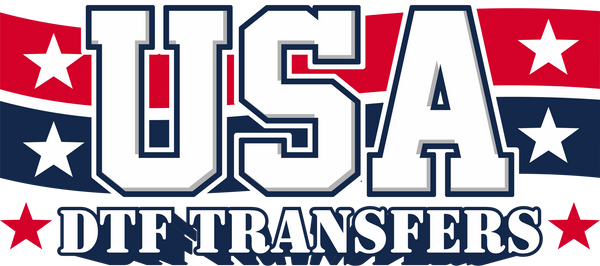Understanding Artwork for DTF Printing: What You Need to Know Before Submitting Your Designs
When ordering DTF (Direct-to-Film) transfers for your custom apparel needs, the quality of your artwork plays a huge role in ensuring your prints come out crisp, vibrant, and professional. Whether you're a business owner, reseller, or creative individual, understanding how to prepare your designs can make all the difference. Here's what you need to know:
Why Artwork Quality Matters
DTF printing captures fine details and vibrant colors, but poor-quality artwork can result in disappointing prints. Blurry lines, pixelated images, and color inconsistencies often stem from low-resolution designs or incorrect file formats.
Key Artwork Requirements for DTF Printing
To ensure your design looks its best, follow these guidelines:
-
Use High-Resolution Images
- Recommended Resolution: 300 DPI (dots per inch) or higher. This ensures sharp, detailed prints. Designs below 150 DPI often appear blurry or pixelated when printed.
-
File Format Matters
- For best results, submit your designs in PNG or vector formats such as AI, EPS, or SVG. Vector graphics are ideal for DTF printing because they maintain sharpness and quality at any size.
-
Transparent Backgrounds Are Necessary
- Transparent backgrounds are essential in DTF printing. Without them, the background of your image will be printed along with the design, resulting in unwanted solid areas on your garment. Always remove backgrounds unless they are intentionally part of your design.
-
Outline Your Text
- If your design includes text, convert it to outlines (vector paths) to avoid font compatibility issues. This ensures your text appears exactly as intended.
-
Use RGB Color Mode for Vibrant Colors
- While DTF printers use CMYK inks, submitting your designs in RGB color mode ensures the most vibrant results. RGB files provide richer colors and can be used for Pantone color matching, delivering truer, more accurate colors than CMYK files.
-
Avoid Low-Resolution Screenshots or Web Images
- Images copied from websites or screenshots typically have low resolution and are unsuitable for printing. Always use original files or vector designs.
Common Artwork Mistakes to Avoid
- Blurry Images: Caused by low resolution or improper resizing.
- Thin Lines and Small Details: These may not print well and could fade over time.
How to Improve Your Artwork for DTF Printing
If your design isn’t meeting the required standards, here are some solutions:
- Hire a Graphic Designer: Investing in professional design services can ensure your artwork is optimized for print.
- Use Design Software: Tools like Adobe Illustrator, Photoshop, or Canva offer features to improve image resolution and file quality.
- Ask for Guidance: If you're unsure about your design's quality, don't hesitate to reach out. We’re happy to review your artwork and provide feedback.
Final Thoughts
Taking the time to prepare your artwork correctly will ensure you get vibrant, durable DTF transfers that look fantastic on your apparel. At USA Custom Gear, we’re here to help you achieve the best results possible. If you have questions about your design, reach out to us — we’re happy to assist!
Ready to create stunning apparel with DTF transfers? Submit your designs today and let’s bring your ideas to life!

